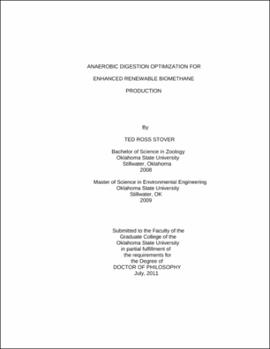| dc.contributor.advisor | Stover, Enos L. | |
| dc.contributor.author | Stover, Ted Ross | |
| dc.date.accessioned | 2013-12-10T18:05:34Z | |
| dc.date.available | 2013-12-10T18:05:34Z | |
| dc.date.issued | 2011-07 | |
| dc.identifier.uri | https://hdl.handle.net/11244/7837 | |
| dc.description.abstract | Scope and Method of Study: The scope of this research project was to operate suspended growth, continuous stirred tank reactor (CSTR) anaerobic digesters at the bench scale level to evaluate improved operation techniques/methods and develop biokinetic relationships. Multiple digester reactors were operated simultaneously for approximately fourteen months to obtain data that was used to develop improved operational processes and biokinetic relationships, along with evaluation of treatment performance under various operating conditions. The goal for developing improved operational processes and biokinetic relationships at the bench-scale level, is to apply the improved techniques and relationships to full-scale biogas/bioenergy production facilities for improved digester operations and enhanced biogas production by producing the maximum specific biogas/methane production rate possible from a given anaerobic digester reactor volume. | |
| dc.description.abstract | Findings and Conclusions: Individual feedstocks chosen for this study when combined to form a co-digestion substrate proved to be highly biodegradable and can be successfully converted to biogas with consistent average methane content between 65% - 70% using anaerobic digestion processes. Specific substrate utilization rate, specific biogas production rate, and specific methane production rate act as a function of mass specific substrate loading rate. Substrate selection, substrate monitoring, and digester monitoring for key analytical testing and online monitoring parameters are critical for maintaining anaerobic digester health, stability, and reliability. Minimizing substrate loading rate peaks and valleys is critical to stable digester operations and maximizing biogas production per unit of reactor volume. Biomass recycle is an excellent option for increased substrate utilization and enhanced biogas production. Operating anaerobic digestion systems for the primary purpose of biogas/bioenergy production, rather than for waste treatment, places greater emphasis on obtaining the maximum specific biogas/methane production rate possible from a given anaerobic digester reactor volume. | |
| dc.format | application/pdf | |
| dc.language | en_US | |
| dc.rights | Copyright is held by the author who has granted the Oklahoma State University Library the non-exclusive right to share this material in its institutional repository. Contact Digital Library Services at lib-dls@okstate.edu or 405-744-9161 for the permission policy on the use, reproduction or distribution of this material. | |
| dc.title | Anaerobic digestion optimization for enhanced renewable biomethane production | |
| dc.contributor.committeeMember | Wilber, Gregory G. | |
| dc.contributor.committeeMember | Sanders, Dee Ann | |
| dc.contributor.committeeMember | Hamilton, Douglas | |
| dc.contributor.committeeMember | McTernan, William F. | |
| osu.filename | Stover_okstate_0664D_11576.pdf | |
| osu.accesstype | Open Access | |
| dc.type.genre | Dissertation | |
| dc.type.material | Text | |
| dc.subject.keywords | anaerobic | |
| dc.subject.keywords | biomethane | |
| dc.subject.keywords | digestion | |
| dc.subject.keywords | enhanced | |
| dc.subject.keywords | optimization | |
| dc.subject.keywords | renewable | |
| thesis.degree.discipline | Civil Engineering | |
| thesis.degree.grantor | Oklahoma State University | |
